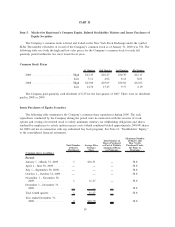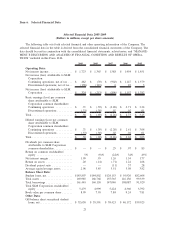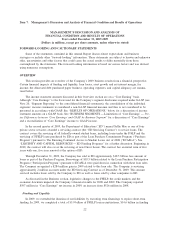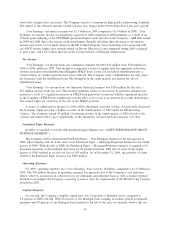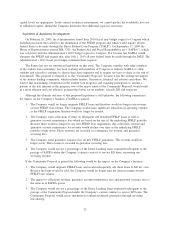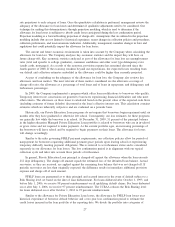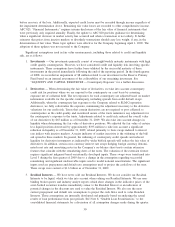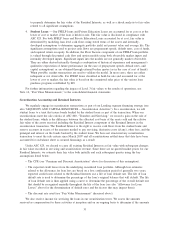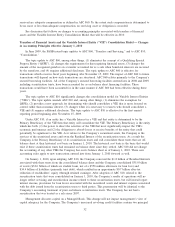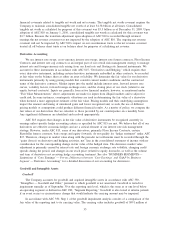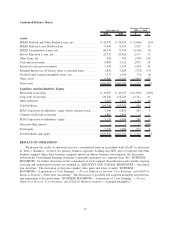Sallie Mae 2009 Annual Report Download - page 30
Download and view the complete annual report
Please find page 30 of the 2009 Sallie Mae annual report below. You can navigate through the pages in the report by either clicking on the pages listed below, or by using the keyword search tool below to find specific information within the annual report.Loan consolidation, default, term extension and other prepayment factors affecting our CPR estimates are
impacted by changes in our business strategy, FFELP legislative changes, and changes to the current economic
and credit environment. If our accounting estimates, especially CPRs, are different as a result of changes to
our business environment or actual consolidation or default activity, the previously recognized interest income
on our student loan portfolio based on the expected yield of the student loan would potentially result in a
material adjustment in the current period.
Fair Value Measurement
The Company uses estimates of fair value in applying various accounting standards for its financial
statements. Under GAAP, fair value measurements are used in one of four ways:
• In the consolidated balance sheet with changes in fair value recorded in the consolidated statement of
income;
• In the consolidated balance sheet with changes in fair value recorded in the accumulated other
comprehensive income section of the consolidated statement of changes in stockholders’ equity;
• In the consolidated balance sheet for instruments carried at lower of cost or fair value with impairment
charges recorded in the consolidated statement of income; and
• In the notes to the financial statements.
Fair value is defined as the price to sell an asset or transfer a liability in an orderly transaction between
willing and able market participants. In general, the Company’s policy in estimating fair values is to first look
at observable market prices for identical assets and liabilities in active markets, where available. When these
are not available, other inputs are used to model fair value such as prices of similar instruments, yield curves,
volatilities, prepayment speeds, default rates and credit spreads (including for the Company’s liabilities),
relying first on observable data from active markets. Additional adjustments may be made for factors,
including liquidity, credit, bid/offer spreads, etc., depending on current market conditions. Transaction costs
are not included in the determination of fair value. When possible, the Company seeks to validate the model’s
output to market transactions. Depending on the availability of observable inputs and prices, different valuation
models could produce materially different fair value estimates. The values presented may not represent future
fair values and may not be realizable.
The Company categorizes its fair value estimates based on a hierarchical framework associated with three
levels of price transparency utilized in measuring financial instruments at fair value. Classification is based on
the lowest level of input that is significant to the fair value of the instrument. The three levels are as follows:
• Level 1 — Quoted prices (unadjusted) in active markets for identical assets or liabilities that the
reporting entity has the ability to access at the measurement date. The types of financial instruments
included in level 1 are highly liquid instruments with quoted prices.
• Level 2 — Inputs from active markets, other than quoted prices for identical instruments, are used to
model fair value. Significant inputs are directly observable from active markets for substantially the full
term of the asset or liability being valued.
• Level 3 — Pricing inputs significant to the valuation are unobservable. Inputs are developed based on the best
information available; however, significant judgment is required by management in developing the inputs.
In August 2009, the FASB issued a topic update to ASC 820, “Fair Value Measurements and Disclosures.”
The update provides clarification for the valuation of liabilities when a quoted price in an active market for the
liability does not exist and clarifies that a quoted price for the liability when traded as an asset (when no
adjustments are required) is a Level 1 fair value measurement. In addition, it also clarifies that an entity is not
required to adjust the value of a liability for the existence of a restriction that prevents the transfer of the liability.
This topic update was effective for the Company beginning October 1, 2009 and was not material to the Company.
On April 9, 2009, the FASB issued three ASC topic updates regarding fair value measurements and
recognition of impairment. Under ASC 320, “Investments — Debt and Equity Securities,” impairment must be
recorded within the consolidated statements of income for debt securities if there exists a fair value loss and
the entity intends to sell the security or it is more likely than not the entity will be required to sell the security
29


